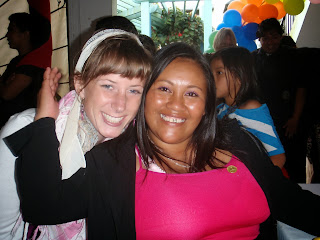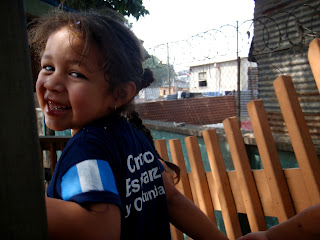I immediately grabbed a co-worker and made plans to see the beach that weekend. The closest and most popular beach to Antigua is Monterrico, a 2.5-hour drive away on the Pacific Coast. It's known for its black volcanic sands and unruly undertow in the surf (you can't really swim there, you'll get pulled under before you can blink). We booked a shuttle to go just for an afternoon. On the way, our driver pointed out signature sights of the coastal lifestyle: farms growing loofah and papaya, others culturing shrimp, and my favorite of all, the home of a family who raised crocodiles in their backyard. Oh, what a business to be in.
The rest of our beach day was spent strolling the hot, grey-black beach, and taking a tour of the mangrove swamp nearby. It was a quiet day outside peak season, so my friend and I were the only ones on the tour. Our original tour guide decided at the very last minute to have lunch at our scheduled time, so he sent his 13-year-old son, Carlos, to guide us instead. We walked behind the family home where they kept their "lanchas" (little dugout canoes), and Carlos led us into the swamp, piloting the boat with a long stick. He showed us through the tunnels formed by the mangrove trees' tangled roots, pointed out birds' nests, lizards, different types of cranes, and flying fish, all the while navigating through a sort of magical network of sunny waters and lily pad fields. It had such a peaceful effect; we were happy to feel lost there, but very glad that Carlos knew the way. It was his backyard, after all.
Where the year went after that, I have yet to comprehend. Suddenly, it was December 6th, and Safe Passage had closed its doors for the year. I didn't want to let them go, but the silver lining in saying good-bye to so many special people was the whirlwind end-of-year tour that began the very next day. With a group of ten colleagues, I boarded a bus to Rio Dulce. Then from bus, we hopped to boat and stayed one beautiful, warm sunset and one cloudy sunrise at a resort on Lake Izabal. Next, another boat down the river to Livingston, where we emerged from towering, tropical green cliffs on either side of the waterway into the open blue Caribbean waters beyond. The same route had once been taken by (real live!) pirates in the 16th century, a fact contributing to many an entertaining daydream during our little cruise. We stayed two nights in Livingston, long enough for me and a few friends to explore Siete Altares (a series of rounded-edged waterfalls attached to the Rio) and spend an afternoon beach bumming and sipping Coco Locos (a coconut sliced open, plus rum) on Playa Blanca. It was the quintessential paradise we had all dreamed of on so many dreary, rainy work days. We saw the sunrise every morning, and we ended the nights with seafood feasts and hammock pow wows.
With my time limited and my bucket list still beckoning, I and a couple friends broke off from the group early to see one more "must." We shuttled our way inland to Semuc Champey, a national park and yet another land of enchanted wonders. We stayed at an eco-lodge that overlooked the park's main attraction: a series of naturally turquoise spring-fed waterfalls and pools, wedged in a thickly forested valley of vines and trees older than history. It was gorgeous. Despite clouds and rain, we went on the full tour of the park, which began with a hike up the cliffs overlooking the pools for a stunning first view. Then, our guide, Toto, took us down to the water, where we followed him (with a great deal of blind trust) on series of short cliff jumps and natural rock slides in and out of the falls and pools themselves. At one point, Toto dove into the water, under a rock ledge, and disappeared, until he emerged a minute later from the other end of the same cliff some twenty feet away. Then, he instructed me to do the same: "Your nose, up! For the air. You go only one second under water." I followed him into the depths and out of sight, under the rock where he revealed a small inner crevice that allowed us to breathe just above the surface. We were walking along the underbelly of the cliff that, from the outside, had appeared completely submerged. That was the first moment in which I thought I was doing the craziest thing I would do all day. But the tour carried on to even more insanity after lunch.
Crossing the iron bridge that hung some 30-40 feet over the river at the foot of the falls, we next entered a cave. Toto turned us over to a cave guide, who handed us each a tall white candle and led us into the darkness. With the candles as our only light, we slowly navigated the freezing underground waters, wading and even swimming when necessary, stopping here and there to take in the dim sight of the beautiful rock formations and massive inner caverns. Then, we stopped. The guide told us to stay put and wait for him to light the way. He scampered ahead, extra candles in hand, into the darkness. You could tell by the way he moved that he was so familiar with every inch of that cave, he probably didn't even need the light. When he finally came back to lead us on, we could see why it took such time. The tunnel ahead rose abruptly, and in order to keep going, we would have to climb, one by one, straight up the middle of a roaring, gushing white waterfall. When my turn came, caveman handed me the rope that was attached somewhere invisibly above, counted to three, and thrust me into the pounding rapids that immediately engulfed me at the base of the fall. Talk about blind trust - all I had was the rope in front of me, and this guy's word that I would make it to the top before I drowned in the rush. Well, okay. Finding my footing and following the rope's trajectory, I climbed into the cascade, and in four careful hoists, miraculously made my way over the top of the waterfall. My friend who had gone ahead of me laughed. "So crazy, right?!" Not much farther along after that, one more pool and one more cliff jump awaited, this one about a 15-foot drop. After the waterfall, that seemed easy. "Jump right in the middle," the guide says. "Otherwise, you hit rocks." Splash, we survived.
After the cave tour, Toto took over again, bought us beer, and handed us inner tubes for a quick but relaxing float down the river. Our adrenaline settled. We thought the tour was over. But after coming ashore, as we walked back up toward the lodge, we crossed the big bridge again. Three quarters of the way across, Toto came to a halt and began collecting our tubes. He pointed to a spot in the murky river waaaaaaaay down below: "You can jump here." As if it were obvious. My eyes widened as I leaned over to look. There? No. No f***ing way, Toto. This time, he had to be joking. This was no baby cliff jump, this was a method of suicide. I waited for a smile and a "just kidding!" but as I waited, two guys from our tour group hoisted themselves up and over the iron rails and off the edge, just like that. Falling, falling, falling, splash....... and they surfaced. Well, I couldn't let them be the only ones. If your friend jumped off a bridge, would you jump, too? Yes, apparently I would. THAT was the craziest thing I did that day.
I returned home from Semuc the next day with four days left in Guatemala and one more bucket list feat to accomplish: hiking to the peak of Acatenango, the volcano that dominates Antigua's western skyline. And it was to be an unforgettable finale. With a group of eleven friends, I climbed through steep farmland and forest trails, past the treeline and above the clouds, five and a half strenuous hours to our campsite just 200 meters below the summit. From the site, we could see two active volcanoes (Fuego and Pacaya) erupting in the night, the silhouettes of countless distant mountains, the bright lights of the capital, the faint Pacific coastline, and the streaks of shooting stars above. It was the most indescribably beautiful sight I have ever seen. No one wanted to sleep, no matter our fatigue. We sat around the campfire for hours, sharing jokes and favorite memories, and quietly absorbing the dreamlike scene around us. We were awestruck, weary, happy, filthy and exhausted, and on top of the world. I could not have asked for a more perfect ending to the year.
That night, as I looked out over the country, I could see the places I had explored. I thought of the people I had grown to understand, and this little world I had become part of. Or rather, the places and people that had become my world. I felt overwhelmingly grateful for it all. Grateful, and unsure of how it would feel to leave that world behind. But I've come and gone enough times to know that you never fully leave a place once you are part of it. You keep pieces - images, feelings, lessons learned and relationships forged - with you forever. That's how our little worlds evolve, and in turn, how we do. So I head now for the next adventure, knowing Guatemala will be with me for a long time to come.









































